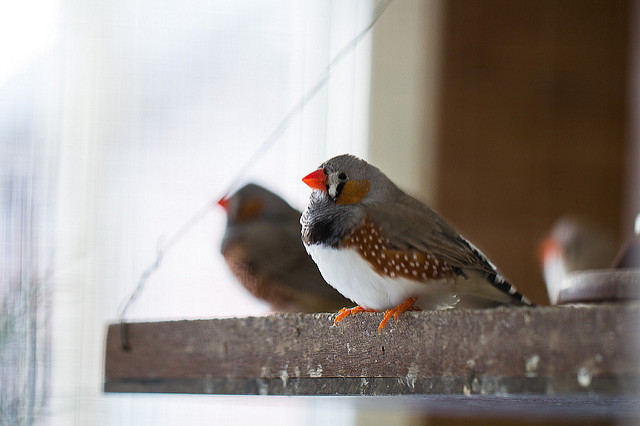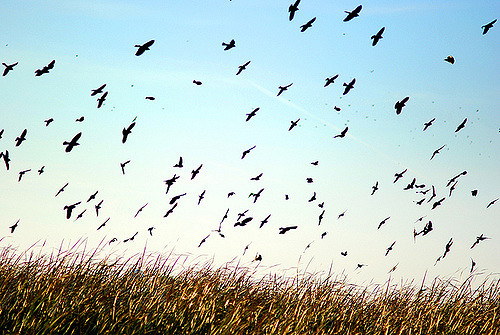By Corrie J. Navis, Department of Biology, Eastern Michigan University
Under the cover of night, a songbird begins its migration northward to its spring breeding grounds. As it flies along under the low clouds, it is largely oblivious to the airspace ahead. Instead, its attention is focused downward as it watches for nighttime predators and uses the physical landscape below for navigation.

Suddenly the bird enters a strange field of sound, like nothing it has encountered before at this altitude. The sound grows louder; the bird slows, looks up, and quickly changes course to veer away from the skyscraper in its path, just in time to avoid a collision. Helping birds avoid such dangerous collisions is one of the goals for researcher Dr. John Swaddle, professor of biology at the College of William & Mary.
For a decade, Dr. Swaddle has been examining how noise created by humans may affect birds. While most research in this area focuses on the harmful effects of noise on birds, Swaddle began to wonder if carefully-controlled noise could actually be a tool for bird conservation.
“If sound is a reliable way of deterring birds from areas… unintentionally,” Swaddle mused, “can we intentionally design and introduce noises that optimally mask and interfere with communication for birds, to try and keep them away?”
Swaddle’s recent research looks at ways of using noise to reduce bird-human conflicts, such as birds colliding with buildings and airplanes, or costly destruction of crops by birds considered pest species.
“My approach to it was very much about protecting the birds,” Swaddle explains, and recalls coming across a newspaper article about bird collisions with airplanes. “I really wasn’t that aware of how wide-scale a problem it was,” he admits. Every time an airplane collides with a bird, the plane must be inspected for damage. Planes spending time out of service cuts into airlines’ profits. In the worst-case scenarios, birds can even bring airplanes down—such as in the case of the “miracle on the Hudson” in 2009, when a flock of Canada Geese disabled a plane, forcing its pilots to make an emergency landing on the Hudson River.
Swaddle uses parametric speakers, which can direct sound to specific areas, to create targeted fields of sound—or “sonic nets”—to influence bird behavior. His research is twofold: assessing how sonic nets might be used to keep birds away from certain areas on the ground, and determining if sonic nets can catch birds’ attention before they collide with an obstacle when flying.
Swaddle’s experiments with captive starlings have shown that birds reduce their food intake by nearly half where there is a sonic net in place. To see how wild birds react to sonic nets, he installed them on a military airstrip. The numbers of birds on the airstrip dropped by 80% during the weeks when the sonic net was in use. But why does it work?
“The noise interferes with ways the birds can hear each other and also to listen out for predators, which we actually think is the most important thing,” Swaddle explains. When birds are forced to spend more time watching for predators, rather than listening for them, they move on to less noisy areas. The result is a safer airstrip for the planes that need to use it. Sonic nets could also be used by farmers to keep birds out of fields and orchards during sensitive growing seasons.

Sonic nets probably work a bit differently to directly prevent collisions during flight. When birds fly, their eyes are aimed downward and to the sides, so they are unlikely to notice what’s directly in front of them. “They’re just not looking where they’re going as much as we think they might be doing,” Swaddle explains. Sonic nets can cue them in that something is in their flight path, like a honking car horn alerts a driver that they need to pay attention. Experiments on preventing building collisions are still in the preliminary phases, but the results so far have been encouraging. Zebra Finches in flight experiments reacted to the presence of a sonic net, and changed their angle of flight to slow down and look for obstacles ahead. The early results have Swaddle eager to bring this concept to a larger scale, testing the sonic nets in front of large structures to see if they prevent collisions in practice.
These studies are part of the research that is needed before sonic nets are ready for practical use. For some applications, excluding all birds from an area is not the ideal outcome. For instance, sonic nets installed at farms could keep all birds—and possibly other animals—away from the area. Some of these animals, like those that control insect populations, are desirable to have around crops. One of the next steps of Swaddle’s research is to determine if there are ways to target sonic nets to discourage only the bird species that cause problems for farmers. Some options might be to use the sonic nets at certain times of the year, when flocks of pest birds show up or when crops are especially sensitive.
Swaddle is also looking at the consequences of moving birds away from farms and airports: “They have to go somewhere. Where do they go? Who do they interact with? What is their productivity and their long-term survival like?” These are important questions because addressing a conflict in one area could result in a new problem for the habitat next door.
Buildings, airplanes, and farms aren’t going away anytime soon, and as human populations continue to grow, these bird-human conflicts will need to be addressed for economic, safety, and conservation reasons. “How can we find a good common ground to maximize the benefits for both [humans and birds], in some way?” This question drives Swaddle as he continues seeking innovative solutions to human-bird conflicts. So far, his sonic nets have shown great promise as a method of reducing harm both to birds and to human economic interests.


